Korean Spicy Gochujang Noodles – 10 Min! (VIDEO)
This post may contain affiliate links. Please read our disclosure policy.
Korean Spicy Gochujang Noodles are my go-to meal when I need something easy and satisfying in 10 minutes! It’s a spicy Korean noodle dish with chewy noodles that are coated in a sauce that is creamy, spicy, and SO delicious – perfect for any meal or time of the day!
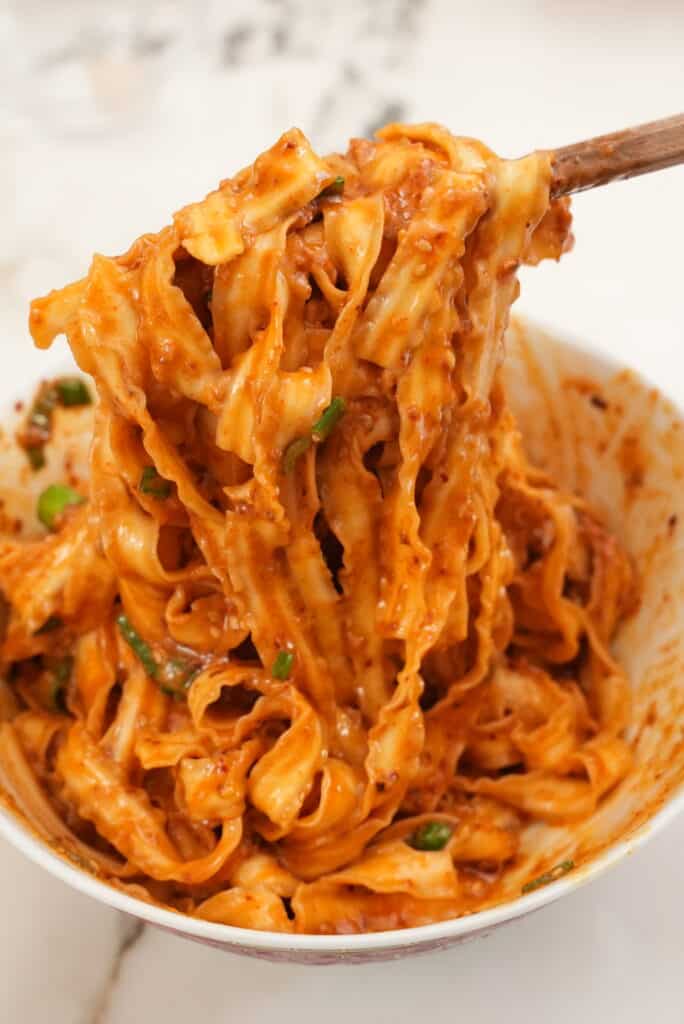
Watch the Korean Spicy Gochujang Noodles Recipe Video Below!
Table of Contents
- Watch the Korean Spicy Gochujang Noodles Recipe Video Below!
- What Noodles Should I Use?
- Ingredients for Korean Spicy Gochujang Noodles
- Gochujang vs. Gochugaru
- Spicy Gochujang Noodles: Recipe Instructions
- Expert Tips for Making Korean Spicy Gochujang Noodles at Home!
- What Should I Serve with Korean Spicy Gochujang Noodles?
- Storage and Reheating Tips
- Spicy Gochujang Noodles Recipe
What Noodles Should I Use?
This is the most commonly asked question whenever I post any noodle recipe. For Korean Spicy Gochujang Noodles, I like using dried noodles by the brand “Wu-Mu”. I find them at my local 99 Ranch. I’m including a picture of the packaging below so you know what to look for if you have an Asian/Chinese grocery near you. They are wavy, knife cut wheat noodles from Taiwan. These noodles have a great mouth feel and pick up a lot of the delicious spicy gochujang sauce – the noodles are perfect for eating with a mouthwatering sauce, like my Sesame Peanut Noodles, Chili Oil Noodles, and Spicy Peanut Noodles! These are perfect for these Korean spicy noodles!
If you can’t find these, I’ve seen these type of noodles by many brands, including Trader Joe’s! You can also substitute with another noodle of your choice; in a pinch, even spaghetti or fettuccine can work! The star of the Korea Spicy Gochujang Noodles is the sauce, so you can be flexible on what kind of noodles you use.

Ingredients for Korean Spicy Gochujang Noodles
- Dried noodles – see note above
- Gochugaru – see note below
- Gochujang – see note below
- Scallions
- Garlic
- sesame seeds
- neutral oil – my go-to cooking oil is avocado oil; you can also use canola or vegetable oil.
- sesame paste – I used Chinese Sesame Paste for this recipe; if you can’t find it, the closest substitute with be a creamy peanut butter with no sugar added. Using. peanut butter with sugar may make the dish too sweet for your liking.
- Mirin – Feel free to substitute 1:1 with sugar if you do not have mirin.
- light soy sauce (low sodium)
- Rice vinegar
- sesame oil
- msg (optional)
- Reserved noodle cooking water – noodle cooking water is used to loosen the sauce, if it is too thick for your liking.
Refer to the recipe card for the full list of ingredients and measurements!
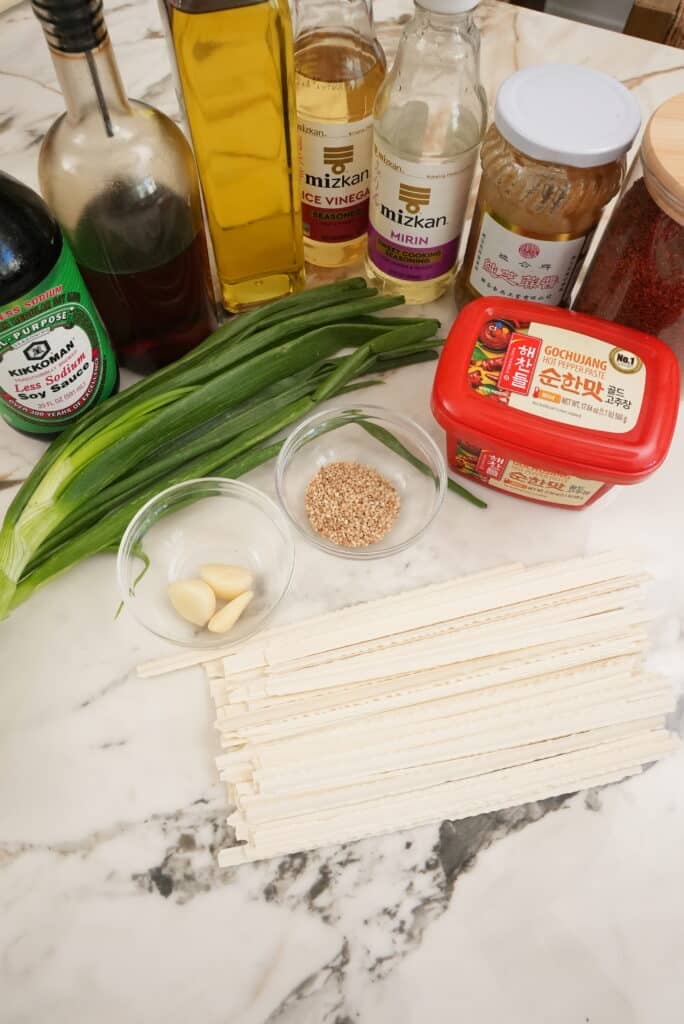
PRO TIPS
Gochujang vs. Gochugaru
Gochujang and gochugaru are similar but very different. They are both key ingredients for Korean cooking, so I’m providing a brief breakdown of the two ingredients below. There are no great substitutes for either of these and they do not work as substitutes for each other. If you want to make Korean food at home, I highly recommend purchasing these two ingredients for your pantry.
Gochujang
- This is a spicy and sweet Korean red pepper paste. It has a strong flavor profile, with a hint of umami. You only need a little to go a long way.
- It is usually sold in tubs of varying sizes at Korean markets. I’ve also seen it at some of my local Ralph’s (in the “Asian” aisle) and on Amazon.
- If you are new to using or eating gochujang, I would consider using 1/2 of what the recipe calls for.
- It’s used in recipes like Spicy Pork Bulgogi, Kimchi Fried Rice, Spicy Honey Garlic Tofu, Gochujang Honey Wings, and Korean Fried Cauliflower.
Gochugari (Korean red chili pepper flakes)
- Gochugaru is Korean red chili pepper flakes (or powder, depending on which version you purchase). It’s vibrant in color and smoky in flavor, and while the heat level varies, it’s definitely on the spicy side. I love using this ingredient because of the layers of flavor it adds.
- It is usually sold in tubs of varying sizes at Korean markets. I’ve also seen it at some of my local Ralph’s (in the “Asian” aisle) and on Amazon.
- If you are new to using this ingredient or if you are sensitive to spice, I would consider using 1/2 of what the recipe calls for.
- It’s used in recipes like Korean Braised Tofu, Spicy Garlic Ramen and Korean Cucumber Salad.
Spicy Gochujang Noodles: Recipe Instructions
1. Make the Gochujang Sauce
In a heatproof bowl, combine scallions, garlic, sesame seeds, gochugaru, and gochujang. Heat 3 tbsp of neutral oil in a pot to 350F-375F and add to the bowl. Stir to combine.

In the same bowl, add sesame paste, mirin, light soy sauce, rice vinegar, sesame oil and mix to combine to form the sauce.
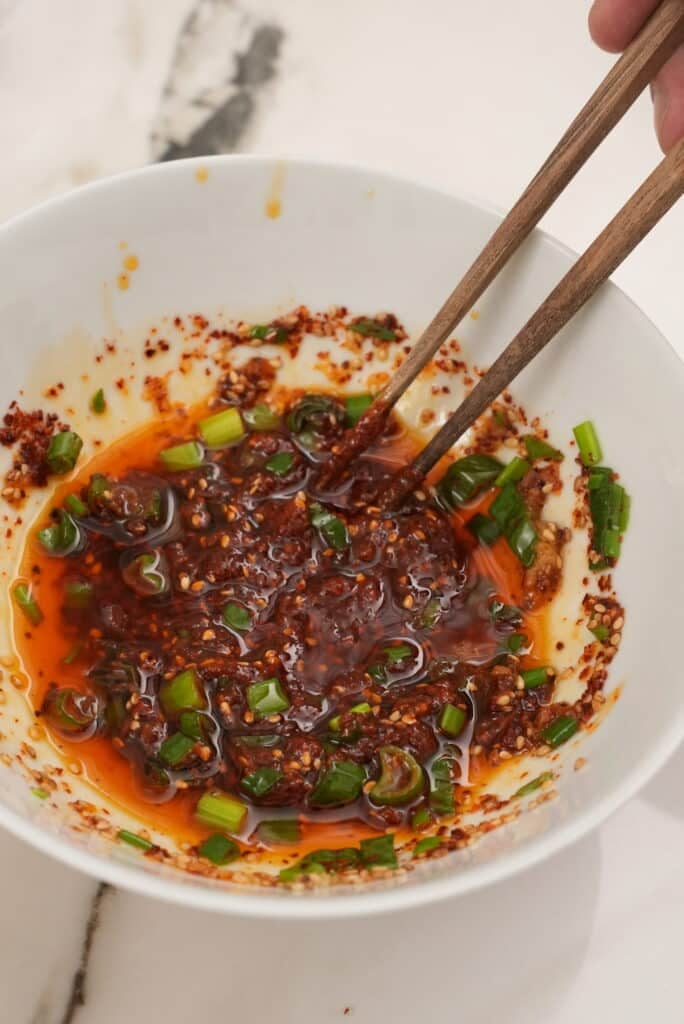
2. Cook the Noodles
Cook dried noodles according to package directions. Drain, reserving 1/2 cup of noodle cooking water.

3. Mix the Noodles with the Sauce
Add the cooked noodles directly to the sauce. Mix the noodles well, using reserved cooking water to loose the sauce as needed.
Garnish with scallions and sesame seeds and enjoy!

PRO TIPS
Expert Tips for Making Korean Spicy Gochujang Noodles at Home!
Noodle Tips
- I like using dried noodles by the brand “Wu-Mu”. I find them at my local 99 Ranch. They are wavy, knife cut wheat noodles from Taiwan. These noodles have a great mouth feel and pick up a lot of the delicious spicy gochujang sauce.
- If you can’t find these, I’ve seen these type of noodles by many brands – I’ve even seen something similar at Trader Joe’s! You can also substitute with another noodle of your choice; in a pinch, even spaghetti or fettuccine can work.
Gochujang vs Gochugaru
- There are no great substitutes for either of these and they do not work as substitutes for each other. If you want to make Korean food at home, I highly recommend purchasing these two ingredients for your pantry. If you are new to using either ingredient or if you are sensitive to spice, I would consider using 1/2 of what the recipe calls for.
- Gochujang is a spicy and sweet Korean red pepper paste; it is usually sold in tubs of varying sizes.
- Gochugaru is Korean red chili pepper flakes (or powder); it is sold in bags.
Noodle Water
- Reserve 1/2 cup of noodle cooking water to loosen your sauce, it is too thick for your liking. I also like to use it to loosen the noodles, as the Korean Spicy Gochujang Noodles will thicken as it sits.
Optional Garnishes
- These noodles are delicious as is – but if you want to take it an extra step and top with optional garnishes, here are some ideas:
- chopped scallions
- crushed peanuts
- thinly sliced cucumber (matchsticks)
What Should I Serve with Korean Spicy Gochujang Noodles?
I love serving Korean Spicy Gochujang Noodles with other Korean dishes – my favorite mains are popular Korean BBQ dishes like Korean Marinated Short Ribs (LA Galbi), Beef Bulgogi, and Spicy Pork Bulgogi.
Korean side dishes are arguably the best part of the meal – dishes like Korean Braised Potatoes, Korean Fish Cakes, Korean Egg Roll, Korean Bean Sprout Side Dish, Korean Marinated Eggs (Mayak Eggs), and Korean Spinach Side Dish are so good!! Korean Cheese Corn and Korean Braised Tofu are my wife’s favorite, so I always make these for her!
Storage and Reheating Tips
If you have leftover Korean Spicy Gochujang Noodles, you can store them in an airtight container in the refrigerator for up to 3 days. They’ll be stuck together when reheating but the flavor will still be delicious! I would microwave them quickly with a little bit of water to loose them up.
If you want to prepare this in advance, you could make just the sauce separately and keep in an airtight container in the refrigerator for 3-4 days. When ready, you just need to cook your noodles and toss in the warmed up sauce.
If you tried this Spicy Gochujang Noodles or any other recipe on my website, please leave a 🌟 star rating and let me know how it went in the comments below!
Spicy Gochujang Noodles

Ingredients
- 6 oz dried knife cut noodles
- 2 tsp gochugaru
- 1 tbsp gochujang
- 2 scallions, chopped
- 3 cloves garlic, minced
- 1 tsp sesame seeds
- 3 tbsp neutral oil
- 2 tbsp sesame paste
- 1 tbsp mirin, or sugar
- 2 tbsp light soy sauce, low sodium
- 1 tbsp rice vinegar
- 1 tsp sesame oil
- 1/4 tsp msg, optional
- 1/2 cup reserved noodle cooking water
Instructions
- In a heatproof bowl, combine scallions, garlic, sesame seeds, gochugaru, and gochujang. Heat 3 tbsp of neutral oil in a pot to 350F-375F and add to the bowl. Stir to combine.
- In the same bowl, add sesame paste, mirin, light soy sauce, rice vinegar, sesame oil and mix to combine to form the sauce.
- Cook dried noodles according to package directions. Drain, reserving 1/2 cup of noodle cooking water, then add the noodles directly to the sauce.
- Mix the noodles well, using reserved cooking water to loose the sauce as needed.
- Garnish with scallions and sesame seeds and enjoy!
Video
Notes
Nutrition
Nutrition information is automatically calculated, so should only be used as an approximation.

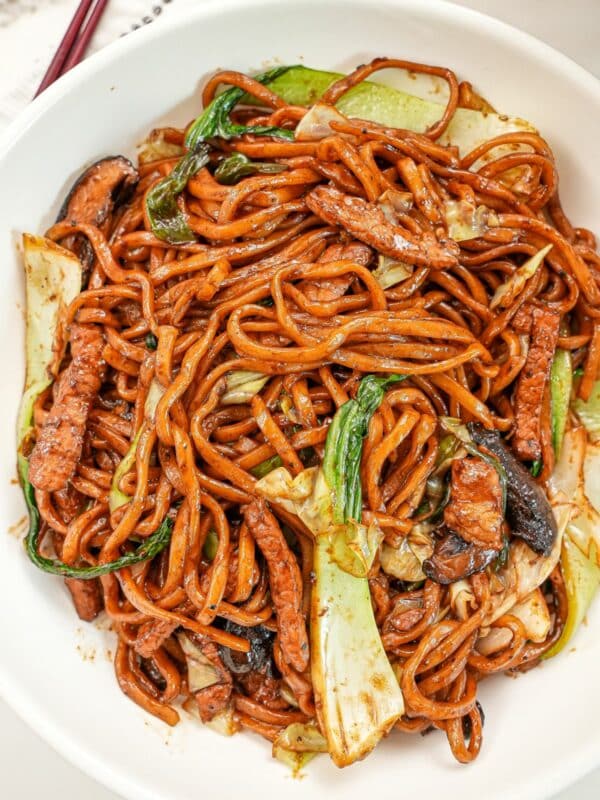
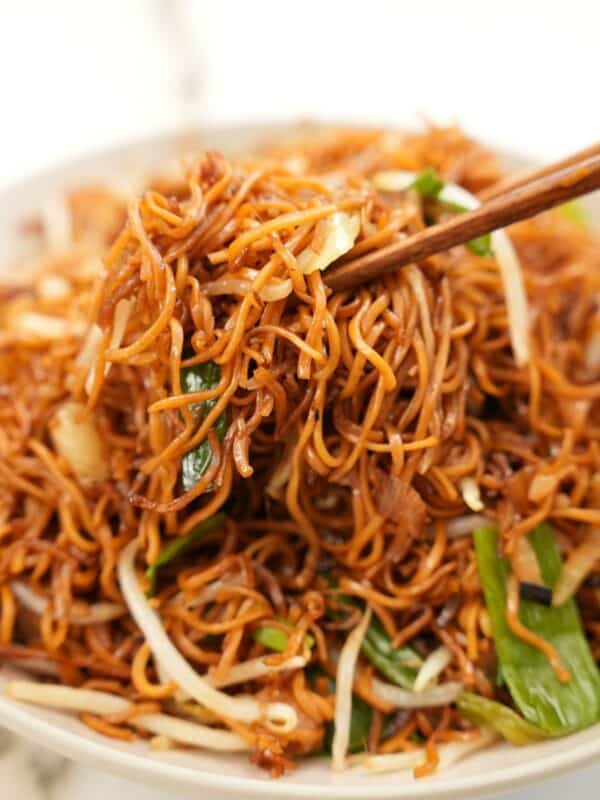
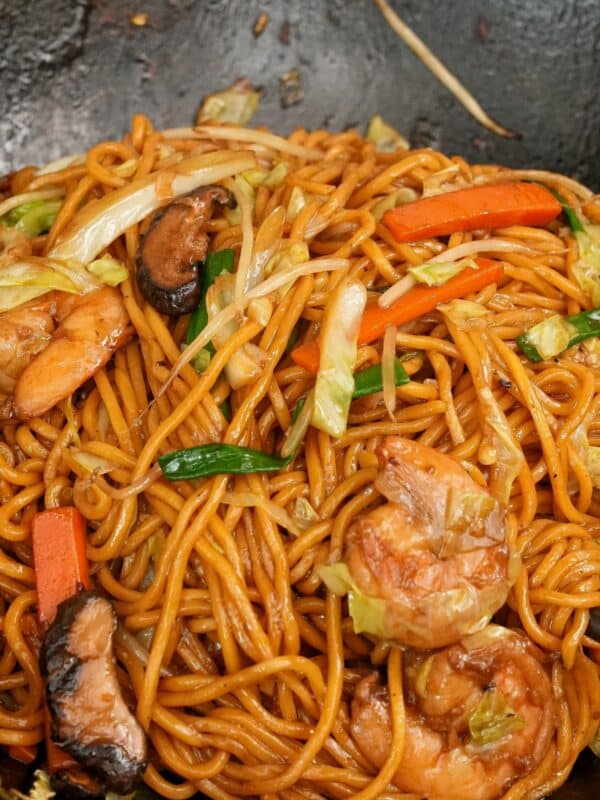
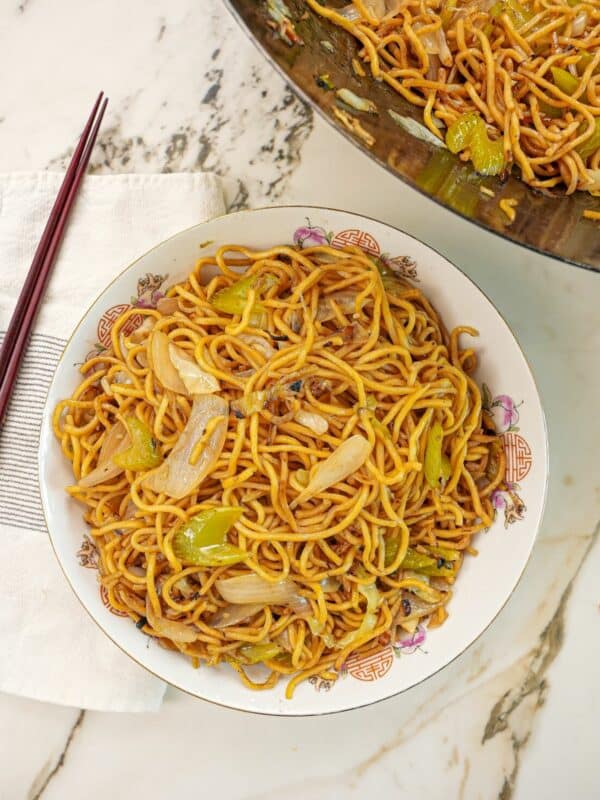







Hi CJ!
I’ve made these twice and absolutely love the concept/ingredients but for some reason it has come out tasting very bitter each time and of the oil (I used a neutral oil). Any ideas why this is happening? I really want to nail this recipe! 🙂 🙂 🙂
Hi Hannah! That is so interesting and having made this many times, I’ve never felt like it turned out bitter! My first thought is that the oil temp may be too hot? That could burn the ingredients and turn them bitter. Also, what type of oil are you using? I typical stick with avocado oil, canola oil or vegetable with great success. Alternatively, I might add a touch more sugar to balance out any potential bitterness. I hope that helps and please let me know if it ends up working out for you!
These noodles are my favorite and a staple that I can count on every time
You nailed it!
I am so addicted that panic sets in if I don’t have the ingredients stocked. Just so quick and tastey. It’s my absolute favourite.
Super simple, super delicious, definitely staying in the rotation. Quick and easy for when your craving some noodles and they are always perfection.
Thanks for another awesome recipe, CJ!
Actually, some of my go-to noodles when I am in a hurry. Very tasty. I need to use sesame paste to get the actual experience I just never have it and peanut butter is an easy replacement. However, because my gf has a peanut butter allergy I can only make it when shes not home
What brand of noodles are you using? They remind me of the noodles I had when I lived in China! Please share! Thank you!
The brand is Wu-Mu and I get them from my local 99 Ranch!
I tried this tonight. Just added some veggies and protein, otherwise followed recipe to the T. It was delicious.
I appreciate the stellar review, Keikei! Thanks for taking the time to write it!
Instant keeper…delicious! I had a hard time sourcing the noodles, 99 Ranch had Wu-Mu but without the wavy/scalloped edge. I found a pink 500g pack of Hadson Toko sliced noodles (Dongguan knife cut noodles) and they seemed to be spot on.
Thanks so much Tommy! So glad it worked out and you found some knife cut noodles!
This looks ….. mmmmmmm.! Any chance you are moving? My neighbor just moved and I need you to live close to me so I can stop by at dinner all the time! Lol almost everything you make looks and sounds delicious
I’ve made this re pie so many times , always a hit. It’s incredible delicious and quick to make